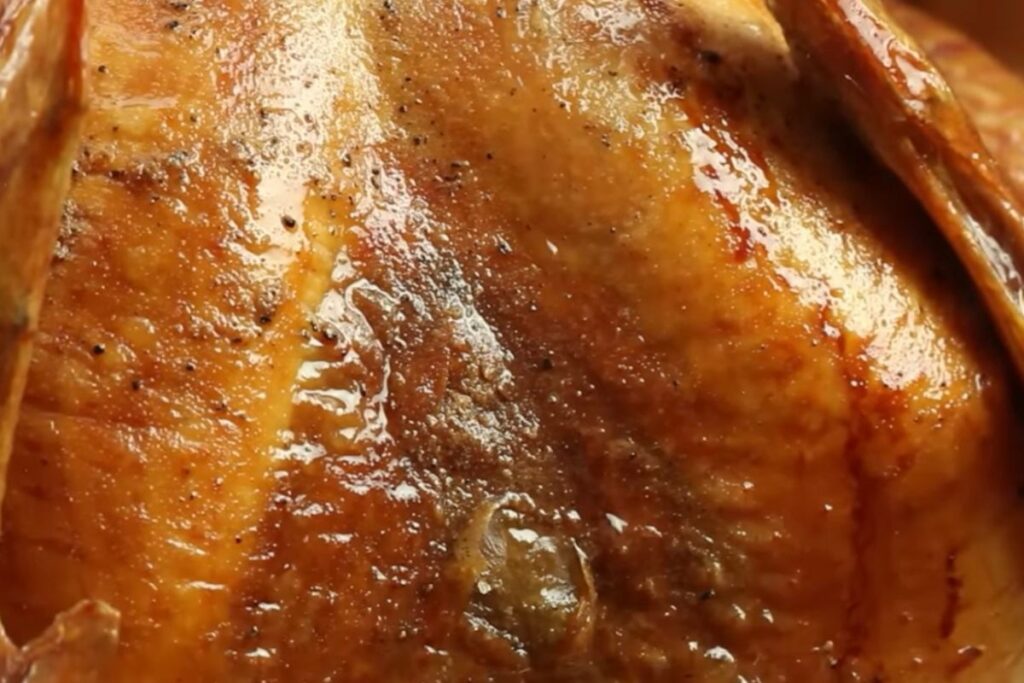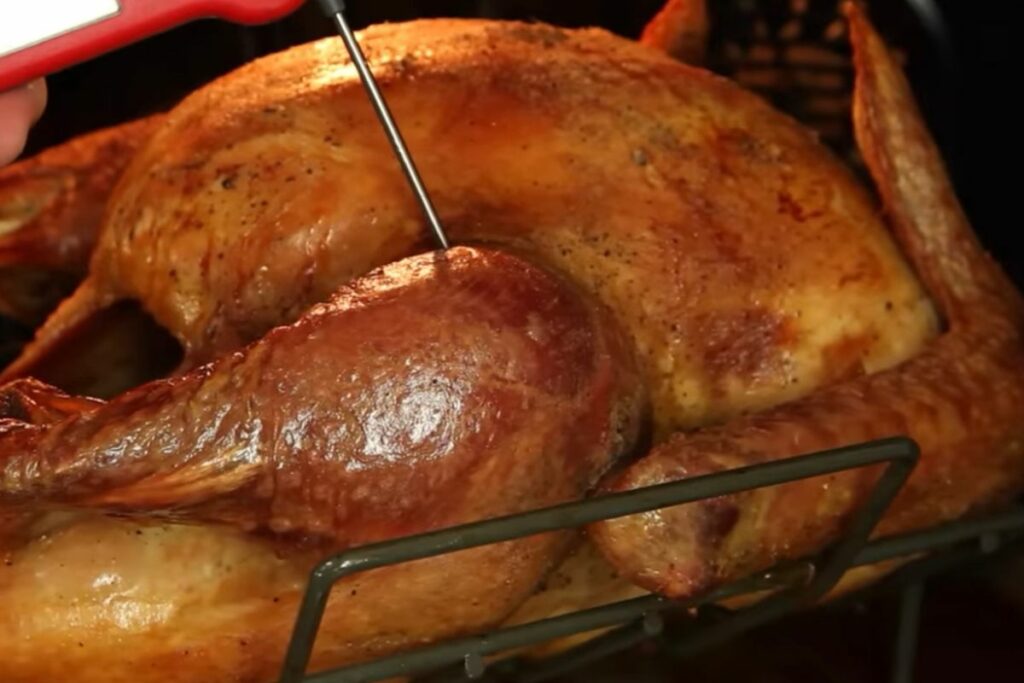Read this article to find out whether 150 degrees is a safe temperature for your turkey, along with some tips on making it extra yummy.

What Does Turkey Fall Under?
Turkey is part of the poultry family. Poultry refers to any domesticated bird that is used for food. These could include chicken, goose, duck, and turkey, among several others. It is also known as white meat, along with fish.
Poultry needs to be cooked at a certain temperature for it to be considered safe to eat, but at what temperature is this exactly?
Temperature, Temperature, Temperature
While harmful bacteria can live in all animals, beef is safe to eat at 145 degrees F, as well as pork. However, when beef is ground, the recommended temperature goes up to 160 degrees F.
This is because bacteria or parasites can spread to the whole batch as you ground the meat. The safe international temperature for cooking poultry is said to be 165 degrees F.
This is a high enough temperature to kill off any harmful bacteria and avoid it contaminating humans that consume it.
Is It Safe To Eat At 150 Degrees?
It turns out that cooking it to 150 degrees ensures that it is much juicier. However, is it safe? It is said that food guidelines are not just about temperature, they are about time as well.
Therefore, if your turkey is at a lower temperature, it needs to stay at that temperature for a particular amount of time before it is safe to eat. This is fine by us, we all let our turkey rest before tucking in, right?
According to the USDA, your turkey can be at a temperature of 150 degrees, as long as it stays at that temperature for at least 3.7 minutes before eating. This is long enough for the bacteria to be killed by the heat.
Thermometers And How To Do It Right
To ensure that you are safe, the best way to make sure you’re cooking your turkey according to guidelines is to use a thermometer.
The best places to check the temperature of your turkey are the deepest part of the breast, the joint between the thigh and drumstick, and the joint between the body and the thigh. There are different kinds of food thermometers to choose from.
Some include:
Dial Oven-Safe Thermometers
These can remain in a place of the food as it cooks. Just insert it two and a half inches into the thickest part of the food and the temperature reading will be ready in around two minutes.
While these are not great for thin foods, they’d be great for a turkey, roast, or casserole.
Instant-Read Thermometers
This type of thermometer isn’t made for being left in the food. These are used after the food has cooked.
Like the previous option, insert the thermometer two inches deep into the thickest part of the food, and the temperature will be shown instantly, in around 10 seconds.
Pop-Up Thermometers And Disposable Temperature Indicators
These are meant for one-time use only. They are good when there is a specific temperature needed, so for cooking a turkey this would be useful.
However, it is recommended that if you are cooking a turkey, you also check its temperature with a conventional thermometer.

Being Aware Of The Safety Around Different Meats
Meats carry many nutrients but they can also carry harmful bacteria such as Salmonella, E Coli, and many others. Ensuring these meats are cooked thoroughly will make sure they are safe to eat.
Raw poultry can be contaminated with Campylobacter and can cause symptoms such as bloody diarrhea, vomiting, fever, and muscle cramps.
Salmonella is also found in raw poultry. The symptoms of this disease are fever, headaches, chills, and vomiting. The symptoms most likely appear around 6 to 72 hours after eating contaminated poultry.
Salmonella is usually spread to chickens and turkeys through rat or mouse feces found in water, food, damp soil, or bedding/litter. It can also be passed down to their eggs if the mother was infected.
Humans are at risk of catching salmonella if they consume undercooked meat that has been contaminated. This is why there are so many regulations and guidelines for cooking this kind of meat.
What Happens If My Turkey Is Still Pink?
If you’ve done everything correctly but some parts of your turkey are still pink in the middle, do not fear. The likelihood is that it is still safe to eat.
To be sure, take the temperature of your turkey. If you have followed guidelines and it is at the correct temperature, then you’re good to go.
Just so you feel assured, let’s go over a few reasons as to why it may be pink. If you’ve smoked or grilled your turkey, that could make it go pink. Myoglobin, a protein found in the muscle could be the cause of this.
Myoglobin can also be a part of a chemical reaction that took place in the oven. Sometimes the gases that form in the oven, react with this protein which forms this color.
If the bird you purchased was a younger one, that could also be a cause of the pink color. Parts of the thighs and drumsticks also tend to be darker in color, the same goes for chicken thighs and drumsticks.
Cooking Tips For Turkey
You may have heard all those comments from the adults at thanksgiving complaining about how hard it was to cook the famous turkey.
However, with the right tips, tricks, and utensils, you really can’t go wrong. Here are some tips to guide you on this turkey journey:
Make A Brine
Brining really enhances the flavor of your turkey and keeps it moist. You can brine it for a few hours or overnight. A simple brine recipe just requires apple juice, salt, brown sugar, ice, and water.
All you need to do is mix these ingredients together and submerge the turkey in it and refrigerate. Once you are ready to cook, discard the brine, but your turkey should have a lovely shiny surface to work with.
Baste Your Turkey
Basting your turkey really adds to the flavor of the skin. A scrumptious baste option would be mixing maple syrup and melted butter. Baste your turkey every 15 minutes during the last hour it is in the oven.
Oven Temperature And Time
Some people prefer to blast the temperature at a high heat of 425 degrees F for half an hour and then reduce.
Your other option is to keep it at a steady temperature of 325 degrees F from beginning to end. The previous method may take time off your cooking, but the lower heat method is a more carefree option.
Let It Sit
If you carve the turkey too soon, you will lose some of the juices. Letting it sit also enables the meat to firm up a bit which makes it easier to carve.
Let it sit for no less than 20 minutes. You can set the table or serve some drinks during this time.
Final Thoughts
To answer the initial question at the start of this article, yes it is safe for your turkey to be at 150 degrees, as long as you don’t eat it the second it’s out of the oven.
Letting it sit for around 4 minutes ensures that all bacteria are killed by the heat, and letting it sit for even longer ensures it is firm enough to be carved and allows all those juices to flow around the meat. Happy cooking!
- Is Blue Steak Safe To Eat? - May 7, 2022
- How To Tell If Your Bratwurst Sausage Is Cooked - May 7, 2022
- The Internal Temperature For Tri Tip When Done - May 7, 2022









